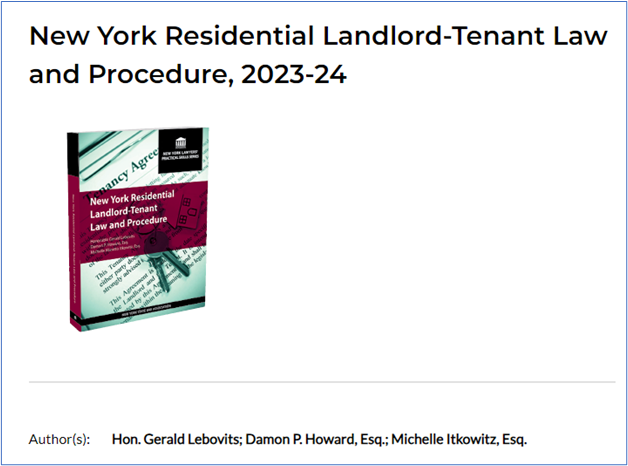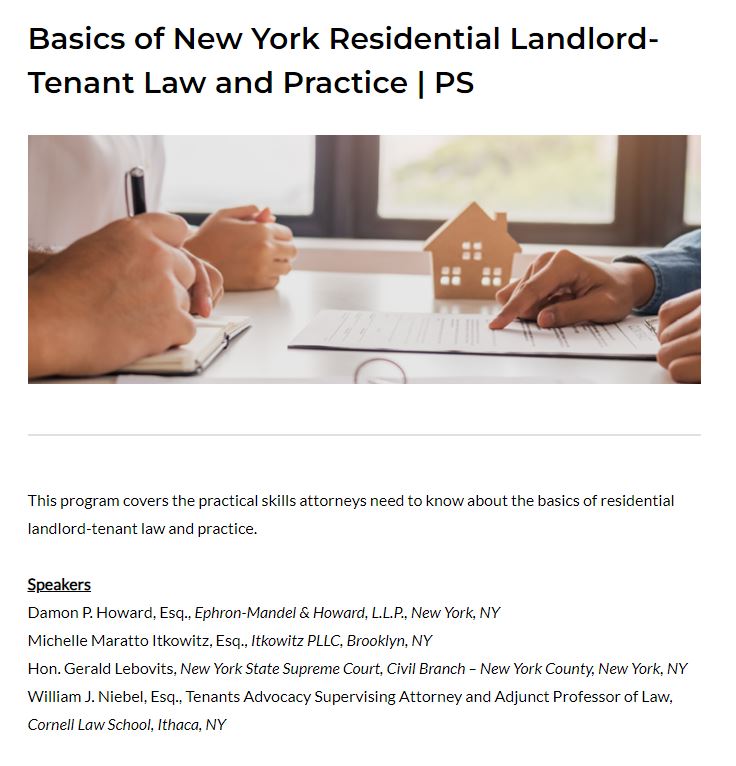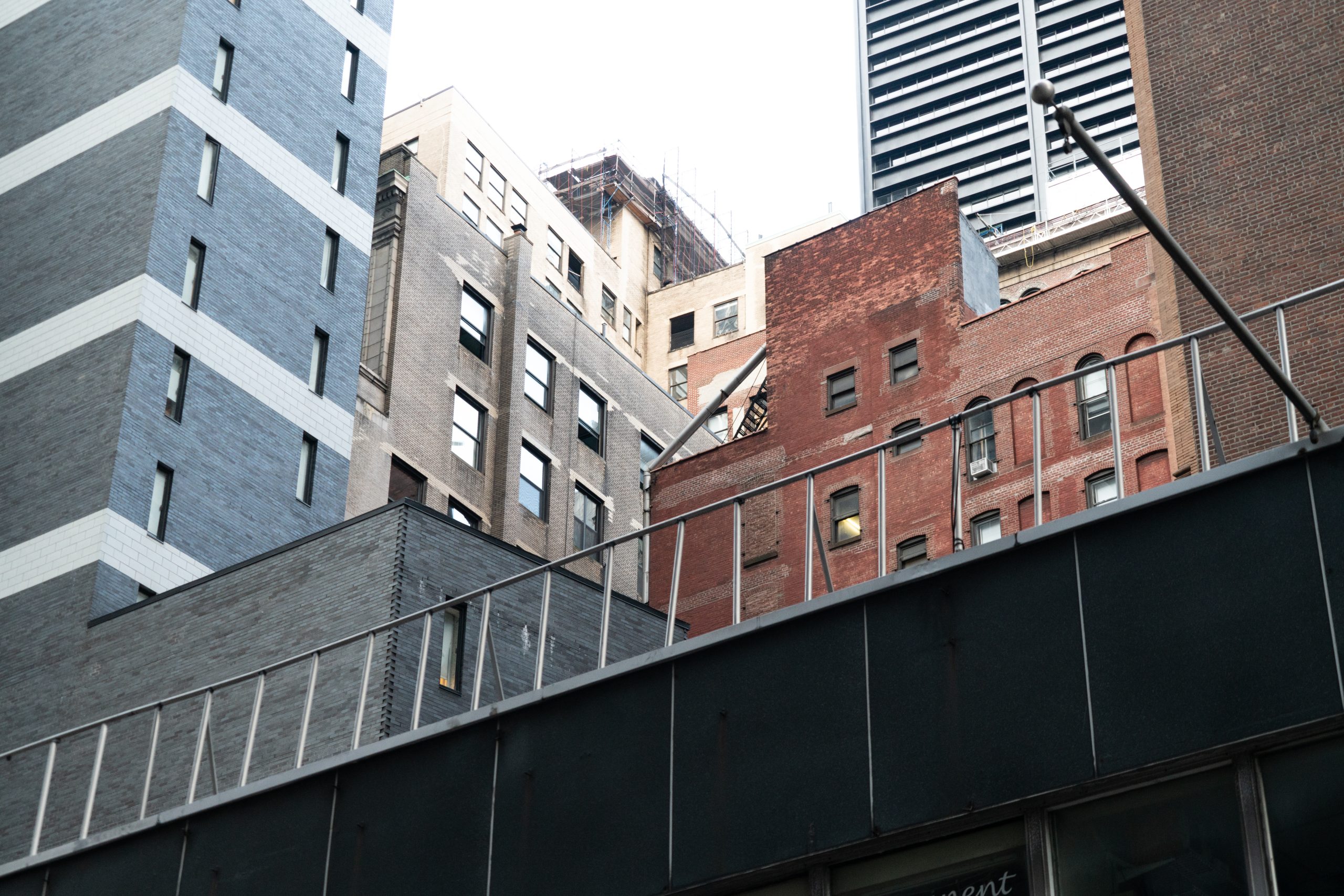Recovery of Use and Occupancy in Summary Proceedings
December 21, 2023
I am incredibly proud to be co-authors with the Hon. Gerald Lebovitz and Damon P. Howard, Esq. of the New York State Bar Association’s 2024 edition of the 436-page, 2,268-footnote “New York Residential Landlord-Tenant Law and Procedure” treatise. Here is a link to the table of contents. The e-book is available now and the hardcopy book is available for sale in January 2024.
On December 7, 2023, the authors taught an accredited continuing legal education program based upon the book materials. A sample slide is below. The program is available for rebroadcast and CLE credit. Below the slide is a section of the book that we explored in the class. I moved the footnotes into the text for this post (the text is in bold, the footnotes are in regular type).

1.6[F] Recovery of Use and Occupancy in Summary Proceedings
Use and occupancy is now routinely granted in summary proceedings. The grant is based on the premise that persons in possession of the landlord’s housing unit “should not be entitled to continued occupancy of the premises without paying for its use.” [Albright v. Shapiro, 92 A.D.2d 452, 453, 458 N.Y.S.2d 913 (1st Dep’t 1983).] It serves to “maintain [the] status quo until [the] rendition of [a] final judgment.” [Id. See, e.g., Eli Haddad Corp. v. Cal Redmond Studio, Inc., 102 A.D.2d 730, 731, 476 N.Y.S.2d 864 (1st Dep’t 1984).] Occupants are not excused from the obligation of paying for the space and services received as an incidence of possession merely because they are involved in litigation with their owner. [Albright, 92 A.D.2d at 453–54.] Fairness and necessity underline these rules; it is economically impossible for owners to render services indefinitely without receiving rent. [See, e.g., Corris v. 129 Front Co., 85 A.D.2d 176, 177, 447 N.Y.S.2d 480 (1st Dep’t 1982).]
Historically, a petitioner could recover only possession and rent arrears in a summary proceeding; use and occupancy could not be recovered. [Seminole Hous. Corp. v. M&M Garages, 47 A.D.2d 651, 651, 364 N.Y.S.2d 26 (2d Dep’t 1975), aff’d 78 Misc. 2d 762, 762, 359 N.Y.S.2d 710 (App. Term, 2d Dep’t, 2d & 11th Jud. Dists. 1974).] In 1976, in response to the holding in Seminole Housing Corp., the Legislature amended RPAPL 741(5) to provide that the relief demanded in a petition may include a request “for the fair value of use and occupancy of the premises if the notice of petition contains a notice that a demand for such a judgment has been made.” [RPAPL 741(5) (amended by 1976 N.Y. Laws ch. 302, effective Sept. 1, 1976, to provide for recovery of damages for use and occupancy); see Ministers, Elders & Deacons of Reformed Protestant Dutch Church v. 198 Broadway, 152 Misc. 2d 936, 939, 579 N.Y.S.2d 543 (Civ. Ct., N.Y. Co. 1991).] Although not part of a possessory judgment in a holdover proceeding, a separate money judgment may still be entered for use and occupancy at the conclusion of the proceeding.
The New York State Legislature did not amend the Uniform Court Acts, which still provide only for the recovery of possession and “rent due without regard to amount.” [N.Y.C. Civ. Ct. Act § 204; UCCA § 204; UDCA § 204; UJCA § 204; see also N.Y.C. Civ. Ct. Act § 110(a)(5).] But because RPAPL 741(5) “is a general provision referring to all applications wherever made,” [Byrne v. Padden, 248 N.Y. 243, 248 (1928) (discussing predecessor provision).] the Legislature’s intent is clear: expand the jurisdiction of all the courts that adjudicate summary proceedings to allow for an award of use and occupancy in addition to rent. [While, with certain exceptions in rent regulated tenancies, the parties set the rent by lease, use and occupancy, which is the nature of a claim based in quantum meruit, can be higher or lower than the rent reserved in the lease. Courts have the discretion to award any amount, pendente lite, the lease amount is typically used to set the use and occupancy to be paid, pendente lite. However, the lease rental rate is only one factor to be considered in fixing permanent use and occupancy.] Use and occupancy may generally be awarded only if it has been demanded in the notice of petition and petition. [See Dimery v. Ulster Sav. Bank, 13 A.D.3d 574, 575, 789 N.Y.S.2d 159 (2d Dep’t 2004); cf. Fisher Ave. Realty Partners v. Hausch, 186 Misc. 2d 609, 611, 720 N.Y.S.2d 322 (App. Term, 2d Dep’t, 9th & 10th Jud. Dists. 2000) (finding that where petition and notice of petition demanded use and occupancy at $820 per month, it was error for court to award use and occupancy at rate of $832 per month).]
Because RPAPL 741(5) does not restrict its application to proceedings in which a landlord-tenant relationship exists between the petitioner and respondent, it has been broadly interpreted as a procedural matter [See Ministers, Elders & Deacons of Reformed Protestant Dutch Church, 152 Misc. 2d at 943.] to permit an award of use and occupancy against any respondent in a summary proceeding, including tenants, [Radin v. Arthur Holding Co., 149 A.D.2d 576, 577, 540 N.Y.S.2d 267 (2d Dep’t 1989) (finding that tenant remains liable for use and occupancy of subtenant whom tenant fails to remove); Stahl Assocs. Co. v. Mapes, 111 A.D.2d 626, 629, 490 N.Y.S.2d 12 (1st Dep’t 1985).] subtenants, [Eighteen Assocs. v. Nanjim Leas. Corp., 257 A.D.2d 559, 559–60, 683 N.Y.S.2d 291 (2d Dep’t 1999); but see Chock Full O’Nuts Corp. v. NRP LLC I, 11 A.D.3d 385, 386, 784 N.Y.S.2d 43 (1st Dep’t 2004).] or licensees, [See Kenilworth Equities Ltd. v. DiDonato, 8 Misc. 3d 130(A), 801 N.Y.S.2d 778 (App. Term, 2d Dep’t, 9th & 10th Jud. Dists. 2005).] whenever equitable principles so require. [See, e.g., BGB Realty, LLC v. Annunziata, 12 Misc. 3d 136(A), 820 N.Y.S.2d 841 (App. Term, 2d Dep’t, 9th & 10th Jud. Dists. 2006) (holding holdover tenant liable for use and occupancy even though tenant was not obligated to pay rent during expired term); but cf. Goldman v. LaFollette Corp., 4 Misc. 3d 128(A), 791 N.Y.S.2d 869 (App. Term, 1st Dep’t 2004) (finding that where corporate tenant held over, its designee, who resided in apartment, would not be held liable for use and occupancy; designee’s occupancy was not “severable” from corporation’s).] The substantive obligation to pay use and occupancy is imposed by law, based on a theory of quantum meruit. [Eighteen Assocs., 257 A.D.2d at 559–60; Wahl v. Warren, 19 Misc. 3d 130(A), 859 N.Y.S.2d 907 (App. Term, 2d Dep’t, 9th & 10th Jud. Dists. 2008); Ministers, Elders & Deacons of Reformed Protestant Dutch Church v. 198 Broadway, 152 Misc. 2d 936, 942, 579 N.Y.S.2d 543 (Civ. Ct., N.Y. Co. 1991).]
The court may also award use and occupancy to the owner in a squatter proceeding. [City of N.Y. v. Schmitt, 11 Misc. 3d 145(A), 819 N.Y.S.2d 847 (App. Term, 2d Dep’t, 2d & 11th Jud. Dists. 2006); Shahid v. Rosado, 2 Misc. 3d 132(A), 784 N.Y.S.2d 924 (App. Term, 2d Dep’t, 2d & 11th Jud. Dists. 2004).]
The landlord has the burden of proving the value of the use and occupancy of the premises. [Carol Mgmt. Corp. v. Ketcham, McLeod & Grane, Inc., N.Y.L.J., Jun. 3, 1981, p. 6, col. 1 (App. Term, 1st Dep’t).] The measure of damages for use and occupancy is generally the fair market rental value of the property [Cooper v. Schube, 101 A.D.2d 737, 737, 475 N.Y.S.2d 52 (1st Dep’t 1984); Wahl, 19 Misc. 130(A).] during the time that possession of the property is retained. [Bedell Co. v. Harris, 228 A.D. 529, 536, 240 N.Y.S. 550 (1st Dep’t 1930); Parker 24 Commercial Assocs. v. Sakow, 14 Misc. 3d 1231(A), 836 N.Y.S.2d 494 (Civ. Ct., N.Y. Co. 2005), aff’d, 14 Misc. 3d 135(A), 836 N.Y.S.2d 494 (App. Term, 1st Dep’t 2007).] One way to determine the fair rental value is to introduce appraisal testimony based on comparable rentals. [Wahl v. Warren, 19 Misc. 3d 130(A) at *1–2; 40 W. 55 LLC v. Kurland, Nos. 570023/02, 02-344-345, 2003 N.Y. Slip Op. 50606(U) at *3, 2003 WL 1088221 (App. Term, 1st Dep’t 2003); 2641 Concourse Co. v. City Univ. of N.Y., 137 Misc. 2d 802, 805, 522 N.Y.S.2d 775 (N.Y. Ct., Claim No. 1987), aff’d, 147 A.D.2d 379, 538 N.Y.S.2d 446 (1st Dep’t 1989).] Objective factual support must accompany expert opinion used to establish comparable values. [150-18-28 Union Turnpike Assocs. v. Bd. of Mgrs. of Vill. Mall at Hillcrest Condo., 12 Misc. 3d 135(A), 820 N.Y.S.2d 844 (App. Term, 2d Dep’t, 2d & 11th Jud. Dists. 2006); 2641 Concourse Co., 137 Misc. 2d at 806.]
Absent proof of comparable rentals, the rental history of the premises may be used to furnish proof of the reasonable rental value of the premises. [Wahl, 19 Misc. 3d 130(A); Pentecost v. Santorelli, No. 2001-1039 5 C, 2003 N.Y. Slip Op. 51178(U), at *2, 2003 WL 21974852 (App. Term, 2d Dep’t, 9th & 10th Jud. Dists. 2003).] Regardless of the method used to ascertain damages, the award is subject to adjustment based on the actual condition of the apartment and any breach of the warranty of habitability. [40 W. 55 LLC v. Kurland, Nos. 570023/02, 02-344-345, 2003 N.Y. Slip Op. 50606(U), at *3, 2003 WL 1088221 (App. Term, 1st Dep’t Feb. 25, 2003); Sterling 41 Partners v. Lareche, N.Y.L.J., Apr. 16, 2001, p. 35, col. 1 (App. Term, 2d Dep’t, 2d & 11th Jud. Dists.); Cent. Realty Mgmt. v. Alcindor, N.Y.L.J., Nov. 9, 2004 p. 31, col. 3 (App. Term, 2d Dep’t, 2d & 11th Jud. Dists.).]
If the apartment is in a multiple dwelling, the absence of a proper certificate of occupancy bars the collection of use and occupancy, just as it is a bar to maintaining a non-payment proceeding or other action to recover rent. [MDL § 302; Sheila Props., Inc. v. A Real Good Plumber, 59 A.D.3d 424, 425, 874 N.Y.S.2d 145 (2d Dep’t 2009); Caldwell v. Am. Package Co., Inc., 57 A.D.3d 15, 24, 866 N.Y.S.2d 275 (2d Dep’t 2008); Hart-Zafra v. Singh, 16 A.D.3d 143, 143, 790 N.Y.S.2d 129 (1st Dep’t 2005).] If the apartment is subject to rent regulation, use and occupancy may be awarded at the full market rent where the occupant against whom it is awarded is not the lawful tenant. [Weiden v. 926 Park Ave. Corp., 154 A.D.2d 308, 308, 546 N.Y.S.2d 595 (1st Dep’t 1989); 72A Realty Assocs. v. Kutno, 15 Misc. 3d 100, 103, 838 N.Y.S.2d 334 (App. Term, 1st Dep’t 2007); 595 Broadway Assocs. v. Bikman, No. 571121/02, 2003 N.Y. Slip Op. 51254(U) at *3, 2003 WL 22220150 (App. Term, 1st Dep’t Aug. 29, 2003).] If the tenancy has not ended, an award of use and occupancy against the lawful tenant may not be greater than the regulated rent, [6 Greene St. Assocs. v. Robbins, 256 A.D.2d 169, 169–70, 681 N.Y.S.2d 530 (1st Dep’t 1998); Sneddon v. Greene, 17 Misc. 3d 1, 4–5, 844 N.Y.S.2d 575 (App. Term, 2d Dep’t, 9th & 10th Jud. Dists. 2007); Ansonia Assocs. v. Bozza, 186 Misc. 2d 845, 846, 721 N.Y.S.2d 897 (App. Term, 1st Dep’t 2000).] but if the landlord prevails in a holdover proceeding and proves that the tenancy was properly terminated, the tenant may be liable for fair market use and occupancy for the holdover period where the possessory judgment in the landlord’s favor removes the apartment from rent regulation. [See 230 E. 14th St. LLC v. Klufas, 16 Misc. 3d 132(A), 847 N.Y.S.2d 899 (App. Term, 1st Dep’t 2007) (landlord entitled to recover fair market use and occupancy where apartment “was removed from the purview of rent control upon the termination of . . . tenancy”); compare 6 Greene St. Assocs. v. Robbins, 256 A.D.2d 169, 681 N.Y.S.2d 530 (1st Dep’t 1998); Clermont York Assocs. v. Feher, 31 Misc. 3d 10, 11, 919 N.Y.S.2d 265 (App. Term, 1st Dep’t 2011) (landlord denied fair market use and occupancy where “lease violation established at trial, subject to tenant’s right to cure pursuant to RPAPL 753(4), did not remove the unit from the ambit of rent stabilization”).]
Because the obligation to pay use and occupancy is not based on an express agreement, a Section 8 tenant who holds over after the expiration of the Section 8 tenancy is liable for the full fair market value [In 541 Constr. Corp. v. Achundia, the Supreme Court denied plaintiff’s motion for an award of use and occupancy. See 79 Misc. 3d 1242(A), *1-*2, 193 N.Y.S.3d 923 (Sup Ct., N.Y. Co. 2023) (G. Lebovits, J.). Plaintiff failed to establish the fair-market value of the unit in which the defendant remained in possession. Id. Plaintiff only proffered evidence it generated itself and referred to inapposite metrics and features. Id.] of the premises, as damages for use and occupancy. [Zappala v. Caputo, 17 Misc. 3d 126(A), 851 N.Y.S.2d 62(App. Term, 2d Dep’t, 9th & 10th Jud. Dists. 2007); Douglas v. Nole, 20 Misc. 3d 1119(A), 867 N.Y.S.2d 16 (Dist. Ct., Nassau Co. 2008).]
In a summary proceeding, a judgment for use and occupancy can be awarded only as an incident to a judgment of possession; if the petition is dismissed, no award of use and occupancy may be made. [Lee v. Pakeman, N.Y.L.J., Nov. 29, 1994, p. 34, col. 2 (App. Term, 2d Dep’t, 2d & 11th Jud. Dists.); Cmty. League of W. 159th St. v. Cesar, N.Y.L.J., Apr. 21, 1989, p. 21, col. 6 (App. Term, 1st Dep’t); Green Props. v. Armstrong, N.Y.L.J., Dec. 3, 2003, p. 22, col. 3 (Civ. Ct., N.Y. Co.).] Because a judgment may not be amended for equitable purposes after it is entered, [Herpe v. Herpe, 225 N.Y. 323, 327 (1919); Claus v. Claus, 37 A.D.3d 517, 518, 830 N.Y.S.2d 279 (2d Dep’t 2007).] a final judgment in a summary proceeding may not be amended to include use and occupancy accruing after the trial. [[Fisher Ave. Realty Partners v. Hausch, 186 Misc. 2d 609, 611, 720 N.Y.S.2d 322 (App. Term, 2d Dep’t, 9th & 10th Jud. Dists. 2000); GMAC Mortg. Corp. v. Carney, N.Y.L.J., Sept. 23, 1997, p. 29, col. 3 (App. Term, 2d Dep’t, 2d & 11th Jud. Dists.); cf. Johnson v. Hunte, 8 Misc. 3d 133(A), 803 N.Y.S.2d 19 (App. Term, 2d Dep’t, 2d & 11th Jud. Dists. 2005); but see 88th St. Realty, L.P. v. Maher, 21 Misc. 3d 190, 192–93, 867 N.Y.S.2d 859 (Civ. Ct., N.Y. Co. 2008) (G. Lebovits, J.), aff’d, 28 Misc. 3d 10, 904 N.Y.S.2d 638 (App. Term, 1st Dep’t 2010). ]
Some courts award use and occupancy only from the commencement of the proceeding. [See Hudson Waterfront Assocs. IV L.P. v. MTP 59 St. LLC, 8 Misc. 3d 136(A), 803 N.Y.S.2d 18 (App. Term, 1st Dep’t 2005).] But landlords are properly entitled to recover use and occupancy “from the time the tenant begins to hold over without the landlord’s consent.” [South St. Ltd. P’ship v. Jade Sea Rest., 187 A.D.2d 397, 397, 590 N.Y.S.2d 209 (1st Dep’t 1992); C&N Camera & Elecs. v. Far- more Realty, 178 A.D.2d 310, 311, 577 N.Y.S.2d 613 (1st Dep’t 1991); N.Y.C. Econ. Dev. Corp. v. Harborside Mini Storage, Inc., 13 Misc. 3d 1218(A), 831 N.Y.S.2d 348 (Civ. Ct., Kings Co. 2006).]
The rule against apportionment, applicable to rents accruing during periodic tenancies and which renders tenants who vacate in the middle of the rental period liable for the full term, is inapplicable to use and occupancy. Use and occupancy is generally assessed only through the date the apartment is vacated. [Wahl v. Warren, 19 Misc. 3d 130(A), 859 N.Y.S.2d 907 (App. Term, 2d Dep’t, 2d & 11th Jud. Dists. 2008); Elliot v. Polny, 132 Misc. 2d 236, 238, 503 N.Y.S.2d 673 (Civ. Ct., N.Y. Co. 1986).]
To the extent that special or consequential damages might otherwise be recovered against a residential tenant who fails to timely vacate, [See Palumbo v. Donalds, 194 Misc. 2d 675, 682, 754 N.Y.S.2d 856 (Civ. Ct., Kings Co. 2003).] these damages do not appear to fall within the ambit of RPAPL 741(5), which permits an award for the fair value of use and occupancy of the premises. [But cf. Montgomery Trading Co. v. Cho, 22 Misc. 3d 135(A), 880 N.Y.S.2d 874 (App. Term, 1st Dep’t 2009) (awarding in hold- over proceeding liquidated damages due under lease if tenant held over).]
A tenant’s failure to pay use and occupancy directed by the court can result in forfeiture of possession. [RPAPL 745(2)(c)(i) provides that “[i]f the respondent shall fail to comply with the court’s directions with respect to direct payment to the petitioner or making a deposit as directed by the court of the full amount of the rent or use and occupancy required to be deposited, the court upon an application by the petitioner shall dismiss without prejudice the defenses and counterclaims interposed by the respondent and grant judgment for petitioner unless respondent has interposed the defense of payment and shows that the amount required to be deposited has previously been paid to the petitioner.”] This remedy is granted more often in the commercial sphere, though. [169 Bowery, LLC v. Bowery Dev. Grp., LLC, 28 Misc. 3d 130(A), 911 N.Y.S.2d 694 (App. Term, 1st Dep’t 2010) (citing RPAPL 745(2)(c)(i) in finding that landlord was properly granted possession when the tenant failed to comply with two orders directing payment of interim use and occupancy); Houston Essex Realty Corp. v. Old Banque Corp., 2 Misc. 3d 138(A), 784 N.Y.S.2d 920 (App. Term, 1st Dep’t 2004) (same).]







